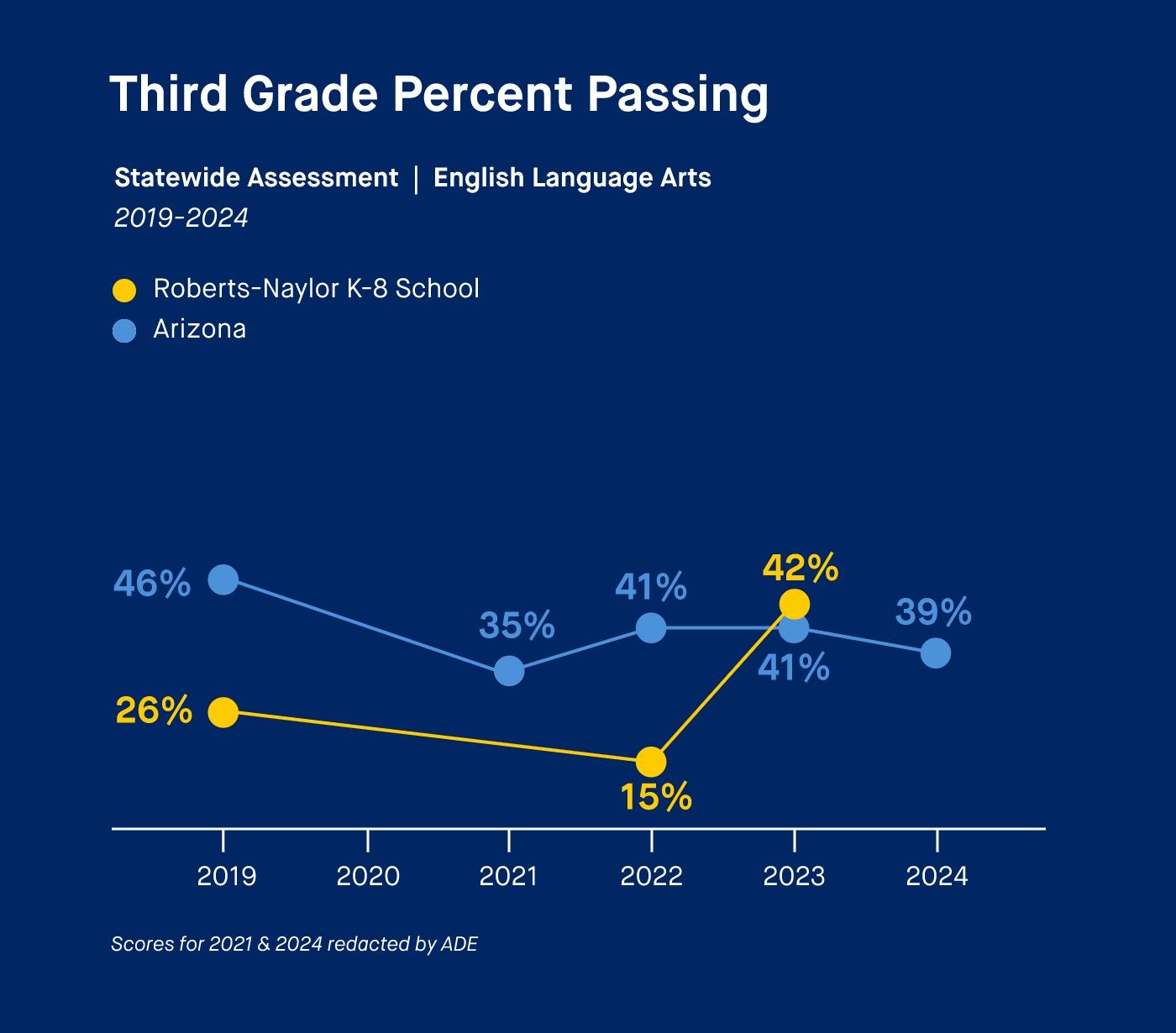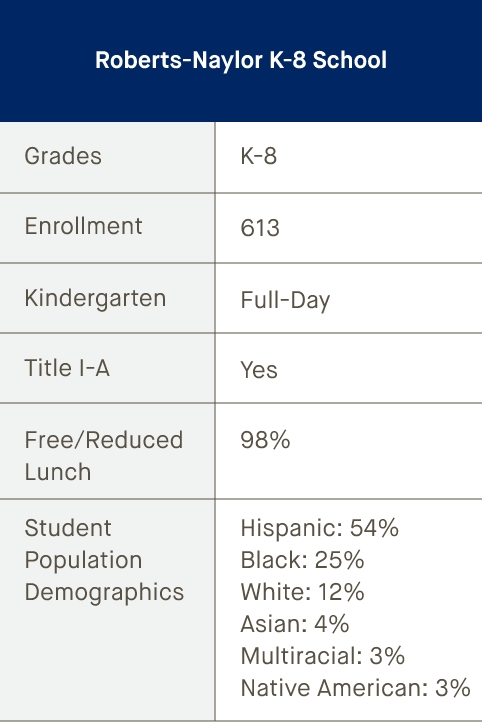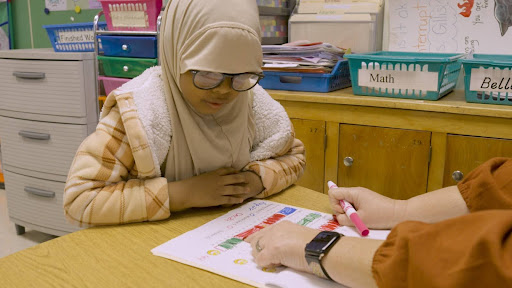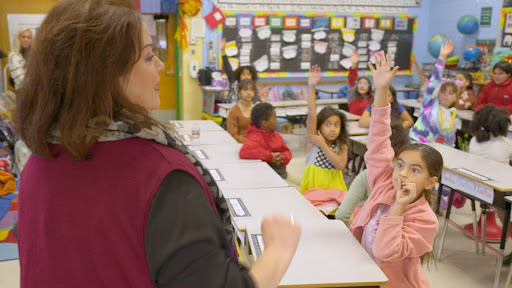
Roberts-Naylor K-8 School

Roberts-Naylor K-8 School
Tucson Unified School District | Tucson, Arizona
The percentage of Arizona third graders passing the state’s English Language Arts assessment — which encompasses reading, language, and writing — remains below pre-pandemic levels; 41% passed in 2022 and 2023, and scores dipped two percentage points in 2024. Statewide passing rates are significantly lower among economically disadvantaged students, English learners, and other key subgroups.
At Roberts-Naylor K-8 School in Tucson:
- The ELA passing rate among third graders jumped from 15% in 2022 to 42%, higher than the state average, in 2023. (The school’s scores for 2024 are redacted.)
- In addition to having more students at or above proficiency, the school also reduced its percentage of students scoring in the lowest proficiency level (“minimally proficient”) from 70% in 2022 to 48% in 2023.

Read On Arizona sat down with four members of the school’s leadership team to learn what they believe are the foundations of their success:
- Using data to motivate and celebrate each student’s progress.
- Differentiating instruction and interventions.
- Supporting teachers to strengthen Tier 1 instruction.
Extraordinary Challenges

Such positive gains in third grade reading would be remarkable for any school, but they are even more worthy of celebration considering the many significant challenges facing the students, families, and educators at Roberts-Naylor.
“We are in a very dangerous area that many people won't drive to, let alone walk around,” said Principal Bernadette Rosthenhausler-Espinoza (“Ms. R”).
Nearly all students qualify for free lunch, and the school serves a large population of refugee students and asylees from apartment complexes in the surrounding area.
“We speak about 15 different languages here,” Ms. R said, including Arabic, Somali, Swahili, Kinyarwanda, Tigrinya, Pashto, Dari, and Farsi.
In addition to the effects of poverty and emotional trauma, many students have had no formal education before coming to Roberts-Naylor and are not literate in their native language. “And, as we know, when a child is not literate in their native language, it's very difficult for them to learn English.”
"What can we do from 8:45 to 3 o'clock to help our students feel safe, feel celebrated, and learn? Let’s do it."
The effects of the pandemic have led to more challenges, as seen in benchmark data at the start of the school year. “Our second graders came in lower than ever,” said Marcella Villasenor, who teaches second and third grades, “and the majority of our third graders came in ‘falls far below’ or ‘approaches’” literacy benchmarks.
Student mobility, a measure of how many students transfer in and out of a school, is another fact of life at Roberts-Naylor. “We have a 60% mobility rate. It’s huge,” Ms. R said. Research shows that high rates of student mobility are associated with lower student achievement and, for English language learners, more time needed to become proficient in English.
“I had between 20 and 30 kids that came in during the testing window,” said Liz Engler, the school’s curriculum support provider and test coordinator. “And those kids have to take the test,” according to ADE’s guidelines, “even if they've never seen a computer in their life and don't speak a word of English.”
The students that stay at Roberts-Naylor from kindergarten through eighth grade are “so successful!” said kindergarten teacher Amie Gillis. “If they're here every single grade, they are just rock stars.”
Despite all the challenges, the team of educators at Roberts-Naylor approach their work with passion, joy, and commitment.
“Our mindset is — What can we do from 8:45 to 3 o'clock to help our students feel safe, feel celebrated, and learn? Let’s do it,” Ms. R said. “This is our vision.”
What key factors drive their success?

- Using data to motivate and celebrate each student’s progress.
The culture at Roberts-Naylor centers on building strong relationships with students, motivating them to make progress, and celebrating every success.
“We try to inspire kids to love reading and math,” said Marcella Villasenor, who teaches second and third grades. “I think that is the key. To love learning.”
Staff uses formative assessment data to help students set goals and have regular “data talks” with students focused on making small steps forward in their literacy skills.
“I don't think there's a kid that likes to do something they're not good at,” Villasenor said. “So I make a huge deal out of every little goal they meet, even if they went from 38% to 40%. ‘Oh, my gosh! You're this much closer to the next level!’ I’m very dramatic, and it’s very motivating for them.”
The school also has parties for reaching benchmarks and proficiency levels to celebrate students’ progress, “even if they improve one percent,” Ms. R said. “Our culture is to celebrate those successes, even the small ones.”
Even the school’s youngest students are tuned into their progress. “Data talks work in kinder, too,” Gillis said. “Kids get excited. We have celebrations. If a child meets the counting to 100 goal, we’ll stop and everyone claps and cheers.”
The school’s culture also includes high expectations for its students, no matter their life circumstances. “We set the bar high for the kids,” Engler said, “and then find a way to bring them to it.”
"Our culture is to celebrate those successes, even the small ones."
When students aren’t making progress, “we look at the why,” Gillis said. “Is it absences? Is there something going on at home? Do they need glasses? Are they food insecure? There are so many things that affect their learning. Then we get our community on board, maybe making a home visit, and we figure out what we can provide to boost them up.”
Because life is difficult for many students at Roberts-Naylor, the school also provides counseling once a week to address their social-emotional needs.
“The number one key to being an effective teacher is to first build strong relationships,” Engler said. “You cannot do anything until you have that. Until kids feel safe, kids feel celebrated, kids feel motivated. And that is a challenge in and of itself.”
- Differentiating instruction and interventions.
The educators at Roberts-Naylor also rely on a variety of formative assessment data to guide reading instruction and interventions for individual students. “We use Benchmark Universe, DIBELS progress monitoring, NSGRA (Next Step Guided Reading Assessment)…It depends on what we’re covering and the problems they’re having,” Villasenor said. “I might use oral fluency for some kids and nonsense reading for others. Whatever gives the complete picture, to know if they’re mastering the standard.”
Reading instruction is the first priority when creating the school’s master schedule. “That reading time is sacred to us.”
The school’s daily Walk to Read program places students with different teachers to work on specific skills. “It’s really fluid. We move kids around so they can be challenged,” Ms. R said. “Some of our kids that may be struggling can get that targeted instruction that’s at their level. And if a kid is really excelling in one area, we can send them for more rigor.”
Interventions are strategically focused. “First, I target the kids that are the easiest to move up to the next level,” Villasenor said. “Then I can teach them in Tier 1. And then I can focus on the next batch of kids that need to move up. It’s efficient.”
"That targeted phonics (ECRI) is working really well, especially for our kids coming in with English as their second language."
Staff has seen value in supplementing its core reading curriculum with Enhanced Core Reading Instruction (ECRI), an evidence-based program (strong evidence) for K-2 students. “That targeted phonics is working really well, especially for our kids coming in with no formal education and with English as their second language,” Ms. R said.
Curriculum and instructional materials are important, but it takes a group of experienced educators to make it all work most effectively.
“We have the tools, but at the end of the day, it’s the people,” Engler said. “The right people to implement it with the right mindset. That starts with the leadership of Bernadette, and Amie and Marcella with their teams. Their support and inspiration. That is the magic fairy dust that is Roberts-Naylor. Yes, the programs are important, but I think it’s the people even more so. ”

- Supporting teachers to strengthen Tier 1 instruction.
While Roberts-Naylor has a core group of highly experienced educators, it has also seen turnover among its new teachers, many of whom are “coming in without enough training, or any formal training, to be a teacher,” Engler said.
Ms. R and Engler, an expert in all the curricula used across the school’s K-8 classrooms, collaborate to support individual teachers with regular classroom “walk-throughs” focused on improving Tier 1 instruction. Engler may visit a new teacher’s classroom as often as three times a week to work on a particular instructional strategy.
“We know that if a teacher has good, strong Tier 1 instruction, then 80% of their kids will begin to make gains,” Ms. R said. “We don't just want pockets of good teachers. We want an entire staff of good teachers that are really strong in Tier 1 instruction.”
"We grow the students, and we need to grow the teachers, as well."
Engler also supports the school’s professional learning communities to help teachers plan lessons aligned with evidence and standards. “Liz is an expert on the curricula,” Ms. R said. “She analyzes benchmark data and brings that to the PLCs.”
“We unpack the standards and dig deep on ESSA to know what skills they need to move out of ‘falls far below’ and reach ‘approaches’ or ‘meets,’” Engler said. “That extra support is helpful.”
Gillis and Villasenor also play leadership roles in mentoring other teachers. Staff feels supported, not judged. And with the mindset of looking for incremental improvement, even the smallest growth in students’ scores serves to boost teacher morale.
“It’s all about growing,” Ms. R said. “We grow the students, and we need to grow the teachers, as well.”
The school’s culture, which flows from the leadership of its principal, has led to an increase in interest from prospective teachers. “I think Bernadette has done an amazing job at letting people see our school for what it really is,” Villasenor said, “and we are seeing a lot more people wanting to come to our school. It is pretty amazing.”
“I’ve received a lot of positive feedback from all our subs, too,” Gillis said. “They say, ‘I love subbing here. I love the community. I feel joy when I come here. I smile every time I walk down your hallway.’”
In the face of so many challenges, the school’s “magic fairy dust,” as Engler put it, is its people.
“I love my staff. They’re just so committed, so passionate,” Ms. R said. “And we've created that culture and climate where we're climbing together. It's rough here, it is, but we do it together.”
Read On Arizona thanks the expert educators at Roberts-Naylor K-8 School for participating in our interview:
- Bernadette Rosthenhausler-Espinoza, Principal
- Liz Engler, Curriculum Support Provider
- Marcella Villasenor, Teacher, Grades 2-3
- Amie Gillis, Teacher, Kindergarten